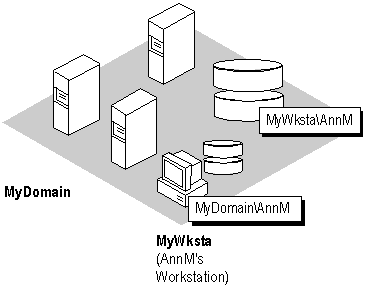
When you log on to a workgroup computer, your logon information is compared with the local user accounts database. When you log on to a computer that participates in a domain, you choose whether to log on locally, or to the domain. (If your domain trusts another domain, you can alternately choose to log on there.)
Note Windows NT Server computers store only domain accounts. To log on to a Windows NT Server computer, you must use a domain account.
For example, suppose AnnM has an account on a domain (MyDomain), as well as an account on a Windows NT workstation (MyWksta) belonging to that domain. When AnnM logs onto her workstation account, the local authentication software uses the information stored in the workstation user accounts database to authenticate the logon. If AnnM logs onto the domain from that workstation, the local authentication software sends the logon request to the domain for authentication. Although they share the same username, each account has a unique security ID.

Figure 4.5 Logging On Locally Versus Logging On to the Domain
As described in Chapter 2, "Windows NT Security Model," of the Windows NT Resource Guide, the Local Security Authority (LSA) creates a security access token for each user accessing the system. This happens when the user logs on and is authenticated (that is, during interactive logon). The LSA also creates a security access token when a user establishes a connection from a remote computer. This procedure is called a remote logon.
For example, suppose AnnM logs on and is authenticated by her local computer and then wants to access a printer controlled by a Windows NT Server computer in domain MyDomain. When she tries to connect to the printer (assuming she hasn't already connected to some other resource in the domain), she is actually performing a remote logon. One of the servers in MyDomain checks the domain's central user accounts database for information to authenticate her account for the domain and then creates a security access token for AnnM, and allows AnnM access.
Note
This type of scenario becomes complex when AnnM uses different passwords for different accounts. For example, if her local password doesn't match the password for her domain account, when she tries to browse the domain or connect to a resource in the domain, a message like the following is displayed on the screen:
System error 5 has occurred
Access is denied
While tools such as File Manager prompt for a valid password, the command-line interface and some applications simply deny access. It is always a better idea to have one set of credentials that apply everywhere in a trusted enterprise.
From an administrative viewpoint, it is important to understand where the user account information is stored. A user's account is either in a private local user accounts database or in a domain user accounts database shared by all the Windows NT Server computers in the domain.